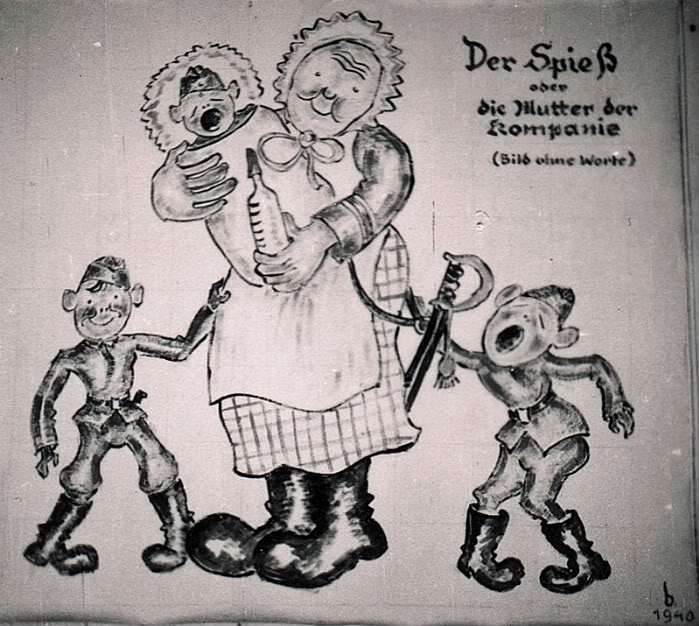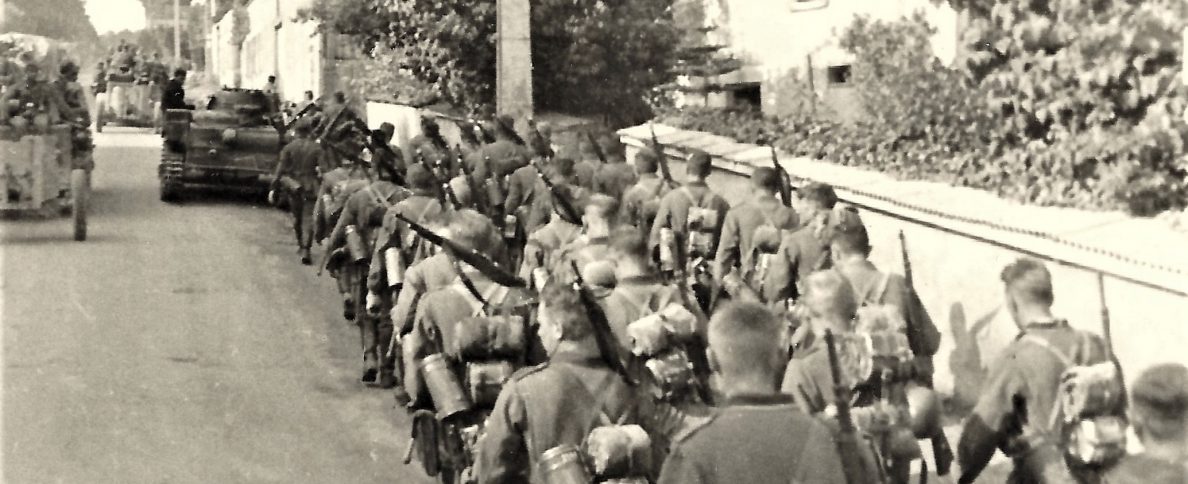Winter isn’t just cold and dark and misery. It can also be fun and games, like building a snowman. It’s an interesting image that those young men, brought up in a dictatorship and fed propaganda, and who conquered large parts of Europe while waging a near-total war, could do something as whimsical as building a snowman. It puts a rather human face on the German soldier, and it would be easy to think that they weren’t capable of horrible things. Unfortunately, many of them were, voluntarily or coerced. That snowman lasted only a few months at best, while its creators went on fighting for Hitler’s Thousand Years Reich.
Month: December 2019
Warm boots
Never underestimate the comfort of warm boots! This photo is probably from the winter of 1942-43, somewhere on the Eastern Front. At least three of the Luftwaffe soldiers are Unteroffiziere (corporals), and if I have to make a guess at their branch of service, it could be the Luftnachrichtentruppen (Air communications corps). The corporals wear their radio operator trade badges on their left sleeves, and the badge on the left breast on the guy on the right could be the Bordfunker-abzeichen (Air radio operator badge). They also seem to have been awarded the Iron Cross, second class.
The weather doesn’t appear to be too cold, as evidenced by the woman wearing just her indoor clothes. Still, the winter boots issued to some troops for the winter of 1942-43 were a combination of a leather shoe and a heavy felt shaft. Instead of the iron hobnails, which carried the cold of the ground into the boot, the soles had flat wooden pegs instead for improved traction. The sitting soldier wears a snow suit with red and/or black identification bands on the sleeves. Just like passwords, the bands were changed into new combinations in order to make it harder for enemy soldiers to infiltrate (after all, one snow-suited soldier looked pretty much the same as the next).
After the horrible winter of 1941-42, the Germans had become better at dealing with wintry conditions. Still, as evidenced by the defeat at Stalingrad in early 1943, winter was a cruel enemy who spared no one who wasn’t prepared.
The Guns of December
A 7,5-cm-leichte Feldkanone 18 team rolls through a wintry forest, the clattering of the hooves and the rumbling of the wheels muffled by the snow. Sound doesn’t travel far in a forest like this, and the trees, their boughs laden with snow, provide excellent cover from prying eyes in enemy reconnaissance aircraft.
The 7,5-cm-le. F.K. 18 was developed in 1930 by the arms manufacturer Krupp and produced in 1938-40. It weighed 2 tons, and could fire a 6 kilo grenade up to 9.7 kilometers. It was a rather mediocre gun, and was superceded by more powerful artillery pieces. Still, it was in use until the end of the war.
Most of German artillery was horse-drawn; motorized or self-propelled artillery battalions were usually reserved for motorized or armored divisions. The reliance on horses caused problems when it came to far and fast the units could travel in a day, and limited the weight and size of the guns as well.
Still, the photo shows a rather idyllic scene, belying the destruction the gun will cause when in its position.
Winter Palace
Camouflage: 100 %. Protection against artillery: 0 %.
In this undated photo, we see some Germans building an igloo. It can’t be too cold, though, as they don’t wear their greatcoats or gloves. They cut blocks of snow with their shovels and managed to build a proper Inuit igloo. Snow has insulating properties, and when finished, it will provide shelter against the cold.
So why didn’t the soldiers exposed to the bitterly cold winter of 1941-42 just build a lot of igloos? Well, the snow has to be firm enough to be cut and stacked; you can’t just turn any old snow drift into a shelter. OK, you can dig out a burrow in a snow bank, but you need to make sure it won’t collapse on you, the snow potentially suffocating you.
So, why build that igloo? It could be the shelter for the relief of an observation post, located on the perimeter of a larger unit. Or it could be just a part of an exercise in winter fieldcraft, but I haven’t read about any such training for German troops. Anyway, it’s another small thread in the weave that is the Second World War.
Greater German holiday
Eight soldiers of the Infanterie-Division Groβdeutschland (“Greater Germany Infantry Division”) getting into the holiday mood, probably near Rzhev, Russia, in December 1942. The canteen cups on the table might contain ersatz coffee, tea, or something stronger. On the plate is what appears to be a Christollen, the traditional German Christmas fruit bread. One of the soldiers play the accordion, and one can almost hear the strains of songs like “Silent Night”. The soldiers have a decidedly more comfortable evening than the Red Army units trapped in the Rzhev salient, engaged in the generally static battle between 8 January 1942 and 31 March 1943 that became known as the “Rzhev Meat Grinder”. The Red Army took heavy casualties in the battle.
The division’s name is seen on the cuff band worn on the right uniform sleeve by the guy on the left, unique among Heer divisions, and in contrast to the Waffen-SS, which wore it on the left sleeve. (Some Luftwaffe units wore cuff titles on the right sleeve, too, as well as the Afrika Korps, while the Heer division Feldherrnhalle wore it on the left). The cuff title denoted the elite status of the Groβdeutschland division, marking it as first among equals, and if one looks closely, the initials “GD” can be spotted on the shoulder boards on a couple of the soldiers.
The two men on the left appear to have been awarded the Kriegsverdienstkreuz (War Merit Cross), indicating that the group belongs to a unit not directly in the front line, maybe the divisional artillery regiment. This is implied further by the fact that the Waffenfarbe edging and embroidered “GD” cypher on the left soldier’s shoulder board aren’t infantry white, but duller like artillery red. The guy on the right is a Leutnant (second lieutenant), and looking really close on the original photo, one can make out that the “GD” cypher is made from metal.
The Groβdeutschland division started out as an elite ceremonial and combat unit in 1921, and grew to regimental size. As the war progressed, it was expanded to divisional status, and from 1943 it was a Panzergrenadier division, ending the war as part of the Panzerkorps Groβdeutschland. The Groβdeutschland fought from the invasion of France in 1940 until the bitter end in East Prussia in May 1945.
Spiess on skis
An Hauptfeldwebel employs the mode of transport – skis – which probably is the best given the circumstances. It’s most likely the winter of 1942-43 on the Eastern Front. His rank is actually Oberfeldwebel (sergeant major), but the two rings of NCO braid around the cuff of his sleeves (nicknamed Kolbenringe – “piston rings”) shows that he’s the company sergeant major and thus a Hauptfeldwebel. He wears the ribbons for the Eastern Front Medal, a long service award (at least four years), and possibly an Iron Cross, 2nd class, as well as the Wound Badge in silver. The map case probably holds blank report forms, rosters and other papers related to his duties.
In the Wehrmacht, the appointment of Hauptfeldwebel was the German equivalent of a Commonwealth company sergeant major or U.S. company-level first sergeant. There was one such non-commissioned officer (NCO) in every infantry company, artillery battery, cavalry squadron, etc. He was the senior NCO of his subunit, but his duties were largely administrative and he was not expected to accompany his unit into an assault or a firefight. The Hauptfeldwebel had many nicknames, including Spieβ (“Spear”) and Mutter der Kompanie (“company mother”). The Spieβ had a small black notebook where he kept notes on the company. No soldier wanted his name in it for the wrong reasons!

‘Tis the season
Another year is drawing to a close, and this blog begin the countdown to the New Year for the third time. Most of us are warm and snug in our homes and can look forward to holidays with friends and family, presents and good food. The people who lived during World War 2 tried to experience some festivity despite the troubled times. On the home front, rationing and worry for family members on the front put a dampener on the celebrations. The men and women serving in the frontlines tried to get a pause from the fighting, hoping to have some peace if only for a few hours. In the prisoner of war camps and concentration camps, there was very little holiday spirit, but even there some observed the holidays, sharing what little they had, and wishing for better times. I hope to convey some of those feelings in the last posts for this year.




